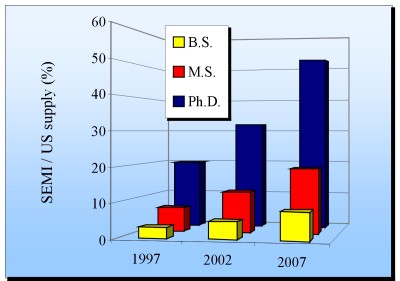|
 |
D. The Demand for Highly Skilled Personnel In the near future, many high-tech companies will be facing a shortage of manpower. For example, the typical distribution of workers in a semiconductor equipment and materials company is as follows: 36% engineer and scientist; 45% technician (2-yr. degree), and 19% other. In the first category, the workforce is divided equally among B.S., M.S. and Ph.D. degree levels. With the industry expected to grow at a 20 to 30% annual rate, California companies will need to hire more than twenty thousand engineers and scientists over the next ten years. These numbers are based on a conservative estimate of 20% employment growth. Companies will probably not grow at a smooth rate as predicted. There will be years where workers are added at a very fast rate, and others where few are hired. However, job growth overall will follow the trend indicated. Currently, California’s higher education system is providing less than 15% of the college graduates required by semiconductor companies. A survey of the largest employers in California found that they hired approximately 4500 engineers in the past four years. Six hundred of these were from Universities located in California, and only 200 were from the UC system. This number will continue to fall in the future, unless something is done to better train our graduates for jobs in this industry. The distribution of employees by technical degree level in a semiconductor equipment company is not typical of that found in other manufacturing sectors. This industry employs a higher percentage of engineers and scientists with M.S. or Ph.D. degrees. Consequently, the demand for these degree holders from the University of California system is much greater than the supply. Shown in Figure 4 is the U.S. employment demand of the Semiconductor Equipment and Materials industry as a percentage of the total supply for the years 1998, 2002 and 2007. Note that the semiconductor chip makers and not included here, although the are an even larger source of demand. The supply includes all those student graduating from U.S. Universities with degrees in Chemical Engineering, Electrical Engineering, Materials Science and Engineering, Mechanical Engineering, Physical Chemistry and Solid-State Physics.
Figure 4. US Employment Demand for the Semiconductor Equipment and Materials Industry The supply of graduates is assumed to increase at 5% per year. Demand is greatest for Ph.D. engineers and scientists, ranging from 20% of the total supply in 1998 to 52% of the total supply in 2007. Since only a small fraction of the students obtaining degrees in the disciplines named above have any experience with semiconductor manufacturing research, it is abundantly clear that there is soon to be a critical shortage of M.S. and Ph.D. engineers with the skills the industry needs. At the Bachelor’s level, the supply of graduates is much greater. However, very few undergraduate engineering, chemistry and physics curricula provide training in semiconductor manufacturing. The engineering skills students are acquiring are not aligned with the needs of today’s high-tech manufacturing companies. While the supply of B.S. graduates is adequate for the semiconductor equipment and materials industry, the skill levels are far below what they require. Hiring companies have no recourse but to invest in expensive, multiyear training programs in order to obtained skilled and productive employees.
|

